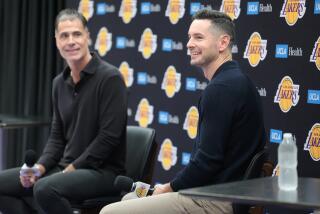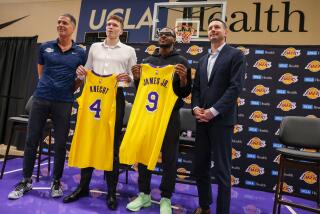No Arena, No Coach, No Worries
ATLANTA — Twenty-seven years ago, Cliff Fletcher’s schedule didn’t include time for sleep.
He fretted over scouting reports, listened to trade proposals, worked the phones to see who might be jump to the fledgling World Hockey Assoc., compiled lists and checked them twice, went about the business of putting together an NHL franchise in the Deep South.
“I think every hockey executive should have to go through it once,” said Fletcher, the first general manager of the Atlanta Flames. “I don’t know if he should have to go through it twice.”
These days, Don Waddell is reprising the frenzied role of expansion-team builder as Atlanta prepares for its second Ice Age, welcoming back the NHL after a 19-year absence.
The Thrashers have yet to hire a coach, and their new downtown arena is still a cluster of exposed beams rising against a skyline that has grown dramatically since the Flames entered the league.
But the new franchise finally takes shape next Friday, when the Thrashers will choose 26 players from a list most of which includes overpriced veterans and youngsters with marginal talent.
The following day, they will take part in their first amateur draft, hoping to build a solid base for the future.
“The adrenaline is really flowing and it’s a critical time for your franchise,” said Fletcher, now a senior advisor for the Tampa Bay Lightning. “You put in some very long hours and your total focus is on trying to put a competitive team on the ice. I’m sure Don is not getting much sleep these days.”
The Flames made the playoffs in their second year, had a winning record in their third and were selling out virtually every game at the old Omni. But interest waned when the initial excitement wore off, and the financially strapped franchise moved to Calgary in 1980.
Waddell hopes to duplicate the Flames’ early success, but his most important priority is building a franchise for the long term.
Nowadays, expansion teams can become quickly competitive -- the Florida Panthers made the Stanley Cup finals in just their third season. But a few wrong decisions can doom a franchise -- the Lightning, who joined the NHL in 1991, are the league’s worst team eight years later.
“These are the two most important days the franchise will ever go through,” Waddell said. “Yeah, there’s a lot of guys who may not be with us when we get to training camp. But the core will be with us three or four years from now, when we’ve built up our team.”
Certainly, Waddell seems to be looking beyond the Thrashers’ initial season when discussing his drafting philosophy. He has some reservations about 18-year-old center Patrik Stefan, the top-rated player in the amateur draft.
Stefan may be available to the Thrashers, who choose second behind Tampa Bay. But the 6-foot-1 1/2, 205-pound youngster has been plagued by concussions, and his agent has been reluctant to let team doctors examine his client. The Thrashers also are considering Pavel Brendl and Jamie Lundmark from the Canadian junior ranks, as well as Swedish twins Daniel and Henrik Sedin.
Brendl is the only other player who might have a chance to play in the NHL next season, according to Waddell, while the twins won’t be available for at least a year because of military commitments in Sweden. They’ve also made clear their desire to play together in the NHL, throwing another monkey wrench into the deliberations.
“Stefan is definitely the most skilled guy in the draft,” Waddell said. “But he has a history of injuries the last couple of years. That throws a little bit of a question mark over him.”
Most of the players who will be wearing a Thrashers uniforms next season are likely to be chosen in the expansion draft. Look for Waddell to follow the same path as the Nashville Predators, who entered the league a year ago and drafted five goaltenders -- the maximum allowed -- and a bunch of low-priced, obscure players.
The Thrashers won’t know who’s available in the expansion draft until after the Stanley Cup finals between Dallas and Buffalo. Nevertheless, other teams already are calling to inquire about goalies who might wind up on Atlanta’s roster.
“Goaltending is definitely the key to any hockey team,” Waddell said. “We can draft up to five goalies, and I look for us to take five. We’ll figure out who’s best for our team and use the other ones as assets to get some regular players (in trades).”
Waddell will focus on speed, but he doesn’t expect to land anyone who’s capable of scoring more than 15 or 16 goals next season.
“I think there will be some veteran players who will be able to help us initially,” he said. “We need a nice mix of veteran guys to go with the younger guys.”
Expansion is very different than in 1972.
The Flames entered a 14-team league; the Thrashers will be joining 27 other franchises. The Flames were accompanied into the NHL by the New York Islanders; the Thrashers are joining alone. Fletcher had to worry about the rival WHA; Waddell has no such concerns.
“That makes it sound a lot easier for the Thrashers than it was back then,” Fletcher said. “On the other side of the coin, the Thrashers are going to find a lot of overpaid players on the available list. That’s so different than it was back in ‘72, when economics really didn’t make a difference.”
One thing hasn’t changed.
The Flames worked out an expansion-draft deal with Montreal to acquire Phil Myre and picked Daniel Bouchard from the Boston organization. Those two goalies were the cornerstone of the franchise in its early years.
“Goaltending,” said Fletcher, sounding a lot like Waddell, “is the key ingredient to be respectable in the formative years.”
More to Read
Go beyond the scoreboard
Get the latest on L.A.'s teams in the daily Sports Report newsletter.
You may occasionally receive promotional content from the Los Angeles Times.






